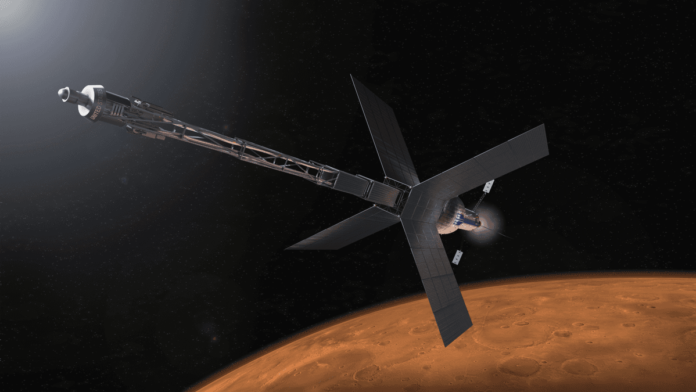One thing we can all agree on about outer space is that places we want to go to are far away. A trip to the Moon from Earth takes at least three days. Another thing we can agree on: if all we have are chemical rockets to get anywhere then almost all of outer space will remain inaccessible to humans travelling from Earth.
Space Propulsion Options Today and Tomorrow
NASA and other space agencies are exploring ways to get from point to point in space. Current and near-future propulsion options include:
- Electric Propulsion – often called ion propulsion. These engines combine electricity with propellant to produce thrust. In space, the electricity can be harvested using large solar panels. You wouldn’t use this form of propulsion to get off the surface of our planet because the level of thrust achieved is relatively small. But in space, electric propulsion can deliver continuous thrust using a minimal amount of propellant to increasingly accelerate your spaceship. This type of engine can move you a long way if the time to get there isn’t a priority. With very little propellant this technology can go very far.
- Solar Sails – use the pressure of high-speed photons from the sun to create propulsion. The photons produce the solar wind that allows a spacecraft to accelerate. Unfurling a large sail like the clipper ships of the 19th century produces thrust. Initially, spacecraft using solar sails would accelerate slowly. But over time the solar sail could give you a good headwind.
- Nuclear Propulsion – has the potential for long-duration space travel. There are different types of nuclear propulsion systems. One works similarly to electric propulsion using a small onboard nuclear reactor to generate heat that then is converted to produce thrust. Another type would use the power of controlled nuclear explosions to accelerate a ship through space. Crew safety in both options would require a shield to protect the crew from radiation. This makes for either very heavy structures with lead or other plate shielding, or large structures separating the living space from the nuclear power source. For the latter think of the Discovery 1 spacecraft in 2001: A Space Odyssey and you get a picture of what one of these would look like.
Science Fiction Propulsion Systems
We should briefly mention two types of propulsion that you can read about or watch in movies and television. These are warp and spore drives.
- Warp Drives – Einstein stated nothing in the Universe can exceed the speed of light. He also stated that light travelling through space can be bent by gravity. Combining these two observations has led to speculation that one could design a warp engine that produces a magnetic field so powerful it warps the space surrounding it. The main structure of the spaceship would lie inside the magnetic field. It could conceivably travel faster than light although, for those riding within it, nothing would seem out of the ordinary. Only to observers from the outside would the spaceship appear to travel faster than its light image. You wouldn’t see it but you could potentially build technology that could track it.
- Spore Drives – Featured on the Enterprise of Star Trek Discovery, these drives rely on a network of microscopic living threads running through the Universe. The idea comes from mycelium networks found here on Earth, the threadlike filaments that accompany fungi like mushrooms. Mycelium are considered to be the largest living organisms on our planet. The writers of Star Trek imagined a similar living network of threads permeating the Universe that could become an interconnected pathway for instantaneous point-to-point travel. It would seem fanciful to presume there could be a mycelial network in space. The closest equivalent to it, the wormhole, is another science fiction-created concept. If you watched the movie Contact, then you get the idea of cutting corners in space to get from point A to point B using futuristic and fanciful technologies.
Warp and spore drives make travel through the galaxy of sci-fi no different than taking a car from one place to another here on Earth. They sound wonderful but they are not reality.
Introducing A Potential Reality: Pulsed Plasma Rockets
What are the nascent other solutions that can bring us closer to speeds that would make travel to Mars and Deep Space viable? Is there anything on the drawing boards? Can a propulsion system produce the thrust that can cut the journey between Earth and Mars from 6 months to 60 days?
If we want to reach Deep Space, establish an easily serviced permanent presence on the Moon, build a colony on Mars, or create artificial cities in space from here to the Asteroid Belt and beyond, then we need to go a lot faster.
Howe Industries, a company located in Scottsdale, Arizona, believes it can build the propulsion system to do the trick. The technology is called a Pulsed Plasma Rocket (PPR). It theoretically can create massive amounts of thrust in short pulses to quickly accelerate large payloads or crewed spaceships to speeds that would shorten the travel time to Mars to as little as two months.
A PPR uses an onboard nuclear power source that would generate 2.5 Gigawatts of electricity to produce 100,000 Newtons of thrust. Newtons are the measure that rocket scientists use for calculating thrust. The greater the number, the faster the rocket can accelerate. A PPR generates pulsed thrusts that if it works will move far faster than any current rocket technology today.
NASA is working with Howe Industries to make the PPR a reality. If they succeed, then Elon Musk’s dream of building a city of one million on Mars becomes possible. The current dream to use SpaceX Starships is more suicidal than real. The risk to humans making the voyage to become Martians is far too great. With a PPR, however, interplanetary travel risk would be dramatically reduced for those onboard who would be less exposed to cosmic radiation that could prove fatal.
















